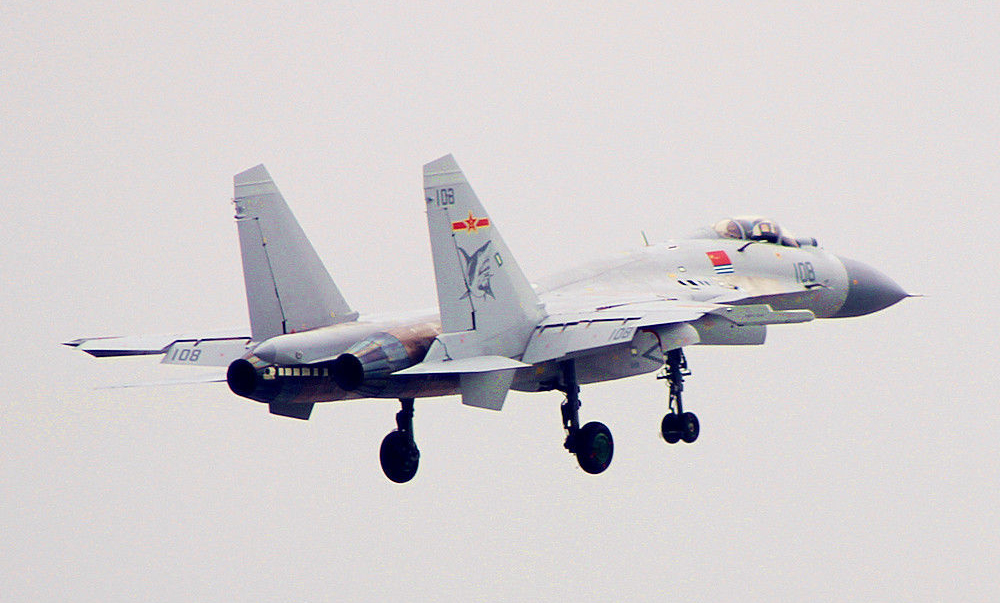
China has put the Shenyang J-15 Flying Shark carrier-borne multirole fighter into serial production, with at least eight production examples known to be flying already. This is in addition to the six J-15 prototypes, some of which conducted carrier trials on board China’s refurbished former Soviet Kuznetsov-class carrier, Liaoning.
Undated photos published on Chinese online forums in October showed J-15s bearing the tail numbers 107 and 108 operating from an undisclosed airfield in China. Both aircraft carried the Flying Shark motif on the tail, along with the People’s Liberation Army Navy (PLAN) ensign on the fuselage, similar to all production J-15s seen so far.
Earlier, in October 2013, Chinese state-run media showed news clips of J-15 production facilities at Shenyang Aircraft Corporation in which they revealed a production aircraft said to be being readied for delivery to the PLAN. This was followed by photos of J-15s bearing tail numbers 100, 101, and 102 appearing on the Internet in early December 2013.
Since then, photos of J-15s bearing sequential tail numbers up to 108 (with the exception of 106) have been published. These aircraft are very likely based at the newly constructed base near Huludao, Liaoning Province. Purpose-built as a carrier training facility, the base boasts of 24 shelters for a regiment of fighter-sized aircraft, maintenance hangars, as well as ski-jumps and flight-deck markings that replicate those found on the Liaoning.
With an article in the Chinese-language Shanghai Morning Post published in August saying that Liaoning’s will embark 24 J-15s, it would mean that China is on its way to fielding its complement of carrier-borne fighters.
It is worth noting that all production J-15s seen thus far have been powered by the Russian Saturn AL-31 turbofan engine instead of the locally-developed WS-10 Taihang. The Russian engine is still used in a number of aircraft types in the People’s Liberation Army Air Force (PLAAF) and PLAN, including the Sukhoi Su-27/30 Flanker and their license-built Shenyang J-11A counterparts, as well as the indigenous Chengdu J-10A/B fighter.
Despite reports of developmental troubles, the stronger WS-10 has been powering Shenyang J-11B (Chinese-built Su-27s with Chinese radar and electronics) land-based fighters built in the past few years for the PLAAF and land-based fighter regiments of the PLAN. Indeed, photos released by the U.S. Navy of the PLAN J-11BH that intercepted a Boeing P-8 Poseidon over the South China Sea in August indicated it was powered by WS-10s.
The WS-10 was also used on at least two of the six J-15 prototypes for a time, although one of the prototypes switched to the AL-31 before its carrier trials on the Liaoning. To date, no WS-10 powered J-15s have been observed in carrier operations. The reason for that reticence to use the WS-10 is unclear, but it is possible that the Chinese are still not satisfied enough with the reliability of the WS-10 to use it for carrier operations.
The Chinese military has acknowledged that it still has a lot to learn about carrier warfare, but there is no doubt that it is making strides in that direction. The limitations of the Liaoning as an aircraft carrier are well known, and it is expected she will serve mostly as a training carrier, building up a core of experienced naval aviators and deck crew.
If reports that China is building more carriers—including ships with catapults for operating aircraft—are true, then it already has a capable platform to work with by the time those ships become operational.





